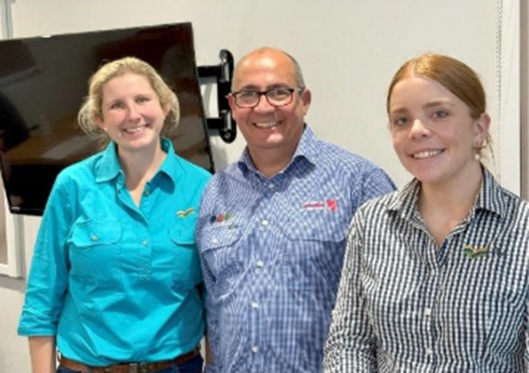 Annie May, Greg Mifsud and Grace Wickson at an MLA PDS event.
Annie May, Greg Mifsud and Grace Wickson at an MLA PDS event.
Wild dog watch: Why connection is the key to control
Wild dogs continue to pose a serious threat to livestock productivity and rural livelihoods across Australia. Thanks to the dedication of experts like Greg Mifsud, however, landholders are gaining tools and confidence to tackle the issue head-on.
With over 30 years of experience in pest management –17 of those focused specifically on wild dogs – Greg has become a leading advocate for sustainable, humane, and best-practice control methods.
As the Centre for Invasive Species Solutions National Wild Dog Management Coordinator, Greg has played a pivotal role in shaping the National Wild Dog Action Plan, and more recently, supporting producers through Meat & Livestock Australia’s (MLA) ‘Improved Beef Productivity through Predator Control’ Producer Demonstration Site (PDS) project.
Building capacity through collaboration
Greg’s work with land managers in central Queensland, particularly the PDS group in Banana, has highlighted the importance of collaboration.
“Dogs don’t obey boundaries or fences; they’re always moving,” Greg said.
“Which is why neighbours working together is so important.”
“Effective dog control is all about keeping numbers down instead of trying to manage the effects of uncontrolled dogs.”
Through mentoring and hands-on training – including trapping schools – Greg has helped producers refine their techniques and achieve better outcomes.
Melinee Leather, a producer member of the Banana PDS group who completed trapping school with Greg, said she found that there was a surprising art to it.
“We all thought we were doing it right, but there’s more to it,” she said.
“We have learned a lot through the PDS. However, our work with Greg is still ongoing.”
Top tips for producers to help manage wild dogs
1. Coordinate with neighbours
“When neighbours work together – sharing sightings, coordinating baiting and trapping schedules, and aligning control strategies – the impact is significantly greater,” Greg said.
“This kind of collaboration helps reduce reinfestation from surrounding areas and builds a stronger, more resilient local network of landholders.”
Greg’s tip: Consider forming a local pest management group or joining an existing one to streamline communication and planning.
2. Use the FeralScan app
“Technology is a powerful ally in pest control,” Greg said.
“The FeralScan app allows landholders to record wild dog activity, damage, and control actions in real time.”
“This data can be shared with neighbours and biosecurity authorities to build a clearer picture of wild dog movements and hotspots.”
Greg recommends using the app not just for logging sightings, but also for identifying patterns such as seasonal movements or recurring problem areas, which can inform more strategic control efforts.
Greg’s tip: Set a weekly reminder to update the app and encourage others in your area to do the same. The more data, the better the insights.
3. Stay informed
Wild dog management is a constantly evolving field, with new research, tools, and techniques emerging regularly.
Greg encourages landholders to stay up to date by visiting the official site for the National Wild Dog Action Plan.
The site offers resources on humane control methods, case studies, training opportunities, and updates on policy and funding.
Greg’s tip: Subscribe to newsletters or alerts from trusted sources like MLA and your local Natural Resource Management group to stay ahead of the curve.
Why it matters
According to Australian Bureau of Agricultural and Resource Economics and Science’s (ABARES) 2014 integrated assessment of the impact of wild dogs in Australia, 66% of land managers reported wild dog problems on their property in the past 12 months, with 34% of them as severe.
While the impact is real and ongoing, Greg’s leadership and the collaborative approach of the National Wild Dog Action Plan are helping communities build resilience and implement humane, effective control strategies.



